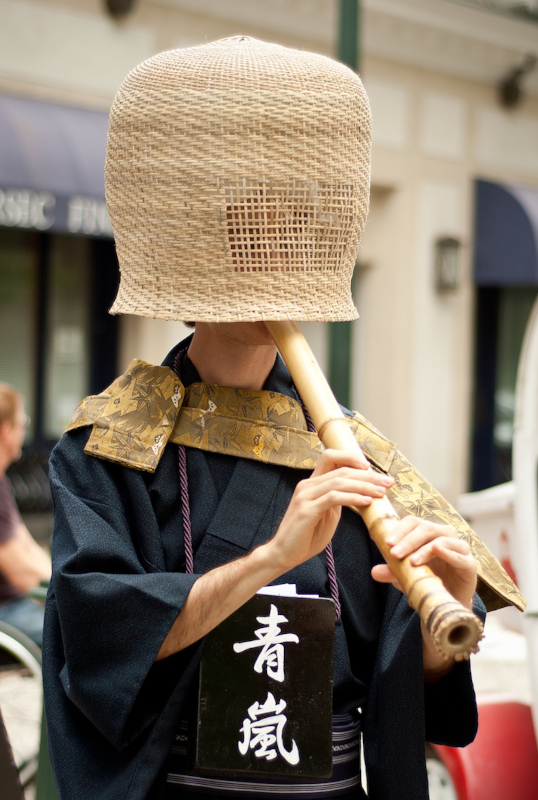Shakuhachi Komuso and Identity - practicing in the streets of America

Practicing formal shakuhachi Takuhatsu Komuso alms begging in Asheville, NC, June 4, 2012 (photo by Steve Shanafelt)
Photos of me weaving my Komuso Tengai hat, 2012



I haven't talked about my times spent practicing Komuso shakuhachi Takuhatsu (often pronounced Takahatsu) in the streets of America from roughly 2012 to 2020. It was a personal practice which I wished to keep off of the internet, which is why I only have one picture of me in the streets, as seen above. (The lovely photo was actually taken without my consent for a news publication. I asked them to take it down out of respect for my religious practice, but they refused. However, a decade later and I must admit that I'm glad to have such a nice photo.)
[Uchiyama Kosho Roshi (1912-1998) wrote, "The attitude of one on takuhatsu must be one of equanimity, whether no donation is received or a large one is received. In fact, the attitude of the mendicant on takuhatsu is one of giving an opportunity to people to materially support a life of one dedicated to zazen and the teaching of the Buddhadharma."]
As for my experiences out there, I hope that by finally relating a bit of of it here it will have some small value for others. Much of the practice was a personal exploration via meditation; reacting or not reacting to various situations that arose out there, be it from living creatures or the elements, "positive" or "negative".
I had no intention of presenting 'myself', rather, I intended to present and embody the practice or act of playing shakuhachi as a Komuso in the streets. My intention was that “my identity” would not and should not matter, however idealistic that was. Instead, I wished for the shakuhachi and its history and imagery to take precedence.
That being said, when you put on a Tengai and play shakuhachi in the streets, especially in a society that largely doesn't recognize much less respect the image of the Komuso, interesting things happen. While there were many beautiful interactions with others, the environment, within myself (no seperation), there were also a fair amount "sketchy" situations (you could say going out in the streets of America and playing shakuhachi as a Komuso is asking for trouble, and you'd be right).
For example, people invaded "my personal space", touching my fingers, clothing, and shakuhachi. They looked up under the Tengai and talk about "me" as if I wasn't there. I was of course threatened, attacked physically, praised, and even borderline worshipped. I suspect that mental health issues were at play with many of these more extreme occurrences.
For some, this all sounds far too relatable, because dehumanization is a part of many people's daily lives in the form of bigotry, its cousin idealization, and of course sexism (I may not be here to write this if my identity under the Tengai wasn't seen or revealed to be "white male"). In all cases, Tengai or no, we’re always encountering people projecting upon us. We can only hope to become a master of our own experience; how we react, or don't react.
I do have some tips for anyone who would go out and play shakuhachi in the streets. Firstly, keep your back to a wall with nothing that can fall on you from above (or be dropped or dumped on you out of a window). Similarly, don’t position yourself near the corner of a building or structure. Lastly, giving your monetary alms to an irate person can defuse a situation, and maybe save you from bodily harm. Most importantly, unlike me, try not to go alone/bring a friend!
To wrap this up, a bit of myth busting: Tengai do not protect one from the rain or wind much at all and, depending on the design, they hardly shield from the sun either. They also make for a poor disguise as anyone bold enough to simply bend down a bit and peer up under the Tengai will be able to see the face of the Komuso wearing it (it's hilarious to me how so many myths in life or assumptions melt like mist when struck by the seeking light of experience).
My favorite moment was when a little girl put a flower in the alms box, Josen
